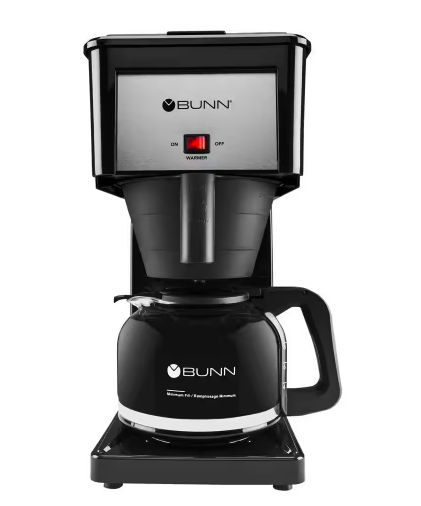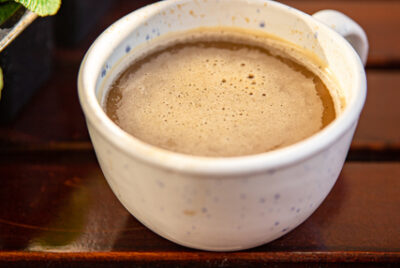How to Clean a Bunn Coffee Maker: Perfect Brews Every Time
Hello fellow coffee lovers! Do you want to know something that stands between you and the perfect cup of coffee? A dirty coffee maker. If you’re an owner of a Bunn coffee maker, understanding how to clean a bunn coffee maker is just as important as understanding how to brew a great cup.
Today, I’m going to share with you how to clean your Bunn coffee maker to keep your brews fresh and your machine running efficiently.
Why Cleaning Your Bunn Coffee Maker Matters
There are several reasons why maintaining the cleanliness of your Bunn coffee maker is of the utmost importance. Let’s delve a little deeper into the impact that a clean coffee maker has on the quality of your brew and the performance of your machine.
Impact on Taste
One of the biggest reasons why you should clean your Bunn coffee maker regularly is the significant effect it can have on the taste of your coffee. Over time, coffee residue, oil, and mineral deposits can build up in your coffee maker. This build-up can affect the brewing process and can result in a cup of coffee that tastes bitter, stale, or simply off.
To avoid this unpleasant experience, a thorough and regular cleaning of your coffee maker is essential. A clean machine means that there are no old residues or buildup to mix in with your fresh brew, so every cup tastes as good as it should – full of flavor, smooth, and true to the taste profile of your chosen coffee beans.
Lifespan of Your Machine
Cleaning your coffee maker isn’t just about preserving the taste of your coffee; it’s also about ensuring the long-term performance of your machine. Just like any other kitchen appliance, the Bunn coffee maker needs care and attention to function efficiently over its lifetime.
Coffee residue, oils, and mineral deposits, especially in areas with hard water, can accumulate in the internal components of the coffee maker over time. If not removed, this build-up can cause clogging, hamper the functioning of the machine, and even lead to premature breakdowns. By cleaning your coffee maker regularly, you’re essentially taking preventive measures to keep it in top shape, thereby prolonging its lifespan.
Think of it like taking your car for regular oil changes or tune-ups. Keeping up with the maintenance keeps your coffee maker running smoothly and reduces the risk of damage or machine failure.
Furthermore, a clean coffee maker also ensures efficient operation. By keeping your coffee maker clean, it will heat and distribute water effectively, ensuring that your coffee is always brewed to perfection. (Speaking of brewed to perfection, click here to learn about how much coffee should be used for 12 cups.)
So, cleaning your Bunn coffee maker is a small investment of time that pays off in the form of delicious coffee and a long-lasting machine. Isn’t it worth it? I certainly think so.
What You’ll Need to Clean a Bunn Coffee Maker
To properly clean your Bunn coffee maker, you’ll need:
- Soft, non-abrasive cloth
- Mild dish soap
- White vinegar
- Toothbrush (optional)
Now that we have everything ready, let’s dive into the cleaning process.
The Cleaning Process
Keeping your Bunn coffee maker clean involves several steps. Each of these steps plays an integral role in maintaining the quality of your coffee and the longevity of your machine. Let’s walk through the cleaning process in a step-by-step manner, so you can feel confident and capable when it comes to keeping your coffee maker clean.
1) Unplugging and Emptying the Coffee Maker
The first step in the cleaning process is to ensure that the coffee maker is unplugged. This is not just an essential safety measure, but also allows the machine to cool down before you start cleaning. Once it’s safe, remove the brew funnel and the carafe from the machine. Dispose of any leftover coffee grounds or liquid. This initial step is all about prepping the machine for a thorough clean.
2) Wiping Down External Components
The next step is to clean the exterior of your Bunn coffee maker. Over time, dust, coffee splatters, and fingerprints can accumulate on the outside of your machine, giving it a dull and dirty appearance. To clean, use a soft, non-abrasive cloth dampened with warm water and a mild dish soap. Wipe down all the external parts of the coffee maker, including the base, handle, and lid.
Be sure to pay close attention to the area around the switches and buttons, as these often get overlooked. Also, remember not to use any harsh cleaning agents or abrasive tools as they can scratch or damage the surface of your machine. Once everything is clean, use a dry cloth to wipe it down, ensuring no water marks are left behind.
3) Cleaning the Brew Basket
The brew basket is where you place your coffee grounds, so it’s prone to residue buildup. To clean it, remove it from the machine and wash it in warm, soapy water. Use a soft brush or sponge to gently scrub the basket and remove any coffee residue or oils. Once cleaned, rinse thoroughly under warm water to remove any soap residue. If your brew basket is dishwasher safe, it can be placed in the top rack of your dishwasher for an easy clean.
4) Cleaning the Sprayhead
The sprayhead is a crucial part of your Bunn coffee maker as it distributes water over the coffee grounds for brewing. To clean it, remove it from the machine and soak it in a mixture of vinegar and water. If there are visible mineral deposits or coffee residue on the sprayhead, you can use a toothbrush to gently scrub them off. After cleaning, make sure to rinse it thoroughly before reattaching.
5) Descaling the Coffee Maker
Descaling involves removing the mineral deposits that build up inside the coffee maker over time. These deposits can come from the water used in brewing and can affect the taste of your coffee and the performance of your machine. To descale your Bunn coffee maker, fill the carafe with a mixture of equal parts white vinegar and water, and run the machine as if you’re brewing coffee. This vinegar solution will help break down and dissolve mineral deposits.
Once you’ve run a brewing cycle with the vinegar solution, let the coffee maker sit for about 15-20 minutes before rinsing. Repeat this process until you no longer smell vinegar.
6) Rinse and Repeat
After descaling, it’s crucial to thoroughly rinse the coffee maker to ensure no vinegar residue is left behind. Fill the carafe with clean water and run the machine through a full brewing cycle. You may need to do this a few times to completely rinse out any remaining vinegar solution.
Remember, keeping your Bunn coffee maker clean isn’t a one-time task. It’s something that needs to be done regularly to maintain the taste of your coffee and the performance of your machine. So make a schedule, stick to it, and enjoy the difference that a clean coffee maker can make to your daily brew!
Maintenance Tips for Your Bunn Coffee Maker
In addition to cleaning, maintaining your Bunn coffee maker properly can help ensure it works optimally for many years to come. Here are some tips to help you keep your machine in the best possible condition.
1) Regular Cleaning
While it may sound like a broken record at this point, regular cleaning is one of the most important parts of maintaining your coffee maker. This includes not just thorough deep cleaning and descaling, but also daily cleaning tasks like rinsing out the carafe and brew basket after each use. Make cleaning part of your coffee-brewing routine and your machine will thank you!
2) Use Soft Water
Hard water is one of the biggest culprits when it comes to scaling in coffee makers. If you can, use filtered or bottled water instead of tap water. Not only will this reduce the buildup of mineral deposits in your coffee maker, but it can also improve the taste of your coffee.
3) Store Properly
When you’re not using your coffee maker, make sure to store it properly. This includes not only making sure it’s clean before storage, but also ensuring it’s kept in a cool, dry place. This can help to prevent the buildup of mold and mildew, which could potentially damage the machine and spoil the flavor of your coffee.
4) Use the Correct Grind Size
Different coffee makers require different grind sizes. For Bunn coffee makers, a medium grind is generally recommended. Using the wrong grind size can not only affect the flavor of your coffee, but also lead to clogs and other issues in your machine.
5) Regular Inspections
At least once a month, take some time to inspect your coffee maker for signs of wear and tear. Check the cord for fraying, inspect the plug and outlet for any signs of damage, and ensure the lid, carafe, and brew basket are all fitting correctly. Early detection of potential problems can help prevent more serious issues down the line.
6) Consult the User Manual
Your Bunn coffee maker’s user manual is a valuable resource. It contains specific instructions for cleaning and maintenance based on your particular model. Always refer to the manual if you’re unsure about anything.
7) Professional Service
If you’ve been maintaining your coffee maker regularly but are still facing issues, it might be time to consider professional servicing. A professional can thoroughly inspect your machine, identify any problems, and conduct repairs if needed.
Maintaining your Bunn coffee maker is not a complicated process, but it does require a commitment. Regular cleaning and maintenance can prolong the life of your machine and ensure that you continue to enjoy delicious, high-quality coffee. So make these tips part of your routine, and you’ll reap the benefits in the form of the perfect brew every time!
Common Problems and Solutions
Despite regular maintenance and cleaning, it’s normal to encounter some issues with your Bunn coffee maker from time to time. The good news is that most common problems have simple solutions. Let’s take a look at a few of these issues and their potential fixes.
1) Coffee Tastes Bad
If your coffee doesn’t taste as good as it usually does, it might be because your coffee maker needs cleaning. As mentioned earlier, residue and mineral buildup can impact the flavor of your coffee. A thorough cleaning and descaling should resolve this issue.
Another potential reason could be the quality of your water or coffee beans. Try changing the water or coffee you’re using to see if that makes a difference. Remember, fresh, good quality beans and filtered or bottled water can make a significant difference in the taste of your coffee.
2) Coffee Maker Not Brewing
If your coffee maker is not brewing, it could be due to several reasons. Check to ensure the machine is plugged in and the switch is turned on. If it is, there might be an issue with the power supply.
Another reason could be a clogged sprayhead. If water can’t flow through the sprayhead properly, it will not be able to brew coffee. Regular cleaning of the sprayhead can prevent this from happening.
3) Overflowing Brew Basket
If the brew basket is overflowing, it’s likely that the sprayhead is blocked or the coffee grind size is too fine. A blocked sprayhead can be cleaned, as discussed earlier. If the grind size is too fine, it can prevent the water from flowing through quickly enough, causing the basket to overflow. Try using a coarser grind and see if that resolves the issue.
4) Coffee Maker Leaking
Leaks can occur due to several reasons. Check the carafe and brew basket for any cracks or breaks. Also, ensure that they are properly aligned with the rest of the machine. If the problem persists, it could be due to a faulty seal or valve, which may require a professional’s attention.
5) Coffee Maker Takes Too Long to Brew
If your Bunn coffee maker is taking longer than usual to brew, it could be a sign that it needs descaling. Mineral buildup can slow down the brewing process, and a descaling should help get things back to normal.
Remember, it’s always a good idea to consult your user manual or contact Bunn’s customer service if you’re unsure or if the problem persists. Regular cleaning and maintenance can help prevent many of these issues, but don’t be afraid to seek professional help if needed. After all, your daily cup of coffee is worth it!
Conclusion
Remember, a clean coffee maker is essential for the best-tasting coffee. It’s not a difficult task, but it does require regular attention. So, take care of your Bunn coffee maker, and it will reward you with delicious coffee for years to come!
FAQs
Q1: How often should I clean my Bunn coffee maker? A: Clean the brew basket and exterior after each use. Descaling should be done every 2-3 months.
Q2: What can I use instead of white vinegar to descale? A: You can use a specialized descaling solution available in the market. For more information on cleaning up coffee like removing coffee stains, click here.
Q3: Can I put my Bunn coffee carafe in the dishwasher? A: If it’s marked as dishwasher-safe, yes.
Q4: My coffee tastes bad, even after cleaning. What should I do? A: It might be time to replace your coffee filters or check the quality of your water and coffee beans.
Q5: My Bunn coffee maker is leaking. What should I do? A: Leaking could be due to a worn-out seal. Cleaning might solve the problem, but if it persists, it’s best to seek professional help.
I hope you found this guide helpful. Let’s enjoy cleaner, tastier coffee together!




